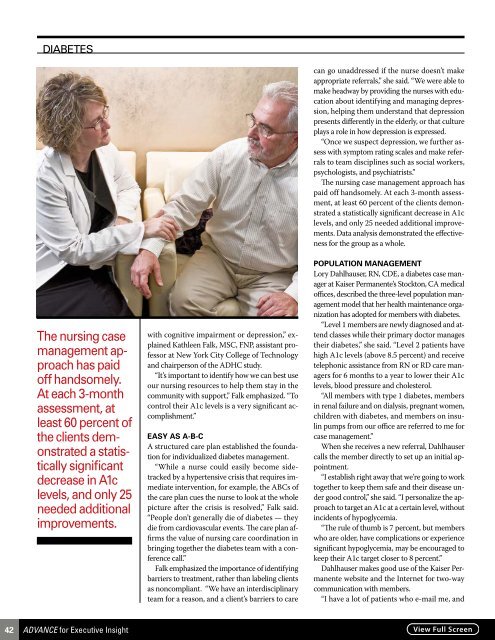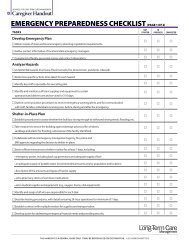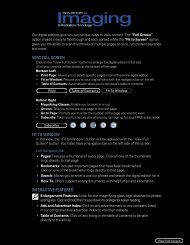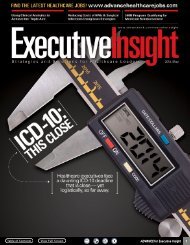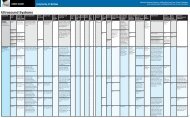1 ADVANCE for Executive Insight
1 ADVANCE for Executive Insight
1 ADVANCE for Executive Insight
- No tags were found...
Create successful ePaper yourself
Turn your PDF publications into a flip-book with our unique Google optimized e-Paper software.
DIABETES<br />
The nursing case<br />
management approach<br />
has paid<br />
off handsomely.<br />
At each 3-month<br />
assessment, at<br />
least 60 percent of<br />
the clients demonstrated<br />
a statistically<br />
significant<br />
decrease in A1c<br />
levels, and only 25<br />
needed additional<br />
improvements.<br />
with cognitive impairment or depression,” explained<br />
Kathleen Falk, MSC, FNP, assistant professor<br />
at New York City College of Technology<br />
and chairperson of the ADHC study.<br />
“It’s important to identify how we can best use<br />
our nursing resources to help them stay in the<br />
community with support,” Falk emphasized. “To<br />
control their A1c levels is a very significant accomplishment.”<br />
Easy as A-B-C<br />
A structured care plan established the foundation<br />
<strong>for</strong> individualized diabetes management.<br />
“While a nurse could easily become sidetracked<br />
by a hypertensive crisis that requires immediate<br />
intervention, <strong>for</strong> example, the ABCs of<br />
the care plan cues the nurse to look at the whole<br />
picture after the crisis is resolved,” Falk said.<br />
“People don’t generally die of diabetes — they<br />
die from cardiovascular events. The care plan affirms<br />
the value of nursing care coordination in<br />
bringing together the diabetes team with a conference<br />
call.”<br />
Falk emphasized the importance of identifying<br />
barriers to treatment, rather than labeling clients<br />
as noncompliant. “We have an interdisciplinary<br />
team <strong>for</strong> a reason, and a client’s barriers to care<br />
can go unaddressed if the nurse doesn’t make<br />
appropriate referrals,” she said. “We were able to<br />
make headway by providing the nurses with education<br />
about identifying and managing depression,<br />
helping them understand that depression<br />
presents differently in the elderly, or that culture<br />
plays a role in how depression is expressed.<br />
“Once we suspect depression, we further assess<br />
with symptom rating scales and make referrals<br />
to team disciplines such as social workers,<br />
psychologists, and psychiatrists.”<br />
The nursing case management approach has<br />
paid off handsomely. At each 3-month assessment,<br />
at least 60 percent of the clients demonstrated<br />
a statistically significant decrease in A1c<br />
levels, and only 25 needed additional improvements.<br />
Data analysis demonstrated the effectiveness<br />
<strong>for</strong> the group as a whole.<br />
Population Management<br />
Lory Dahlhauser, RN, CDE, a diabetes case manager<br />
at Kaiser Permanente’s Stockton, CA medical<br />
offices, described the three-level population management<br />
model that her health maintenance organization<br />
has adopted <strong>for</strong> members with diabetes.<br />
“Level 1 members are newly diagnosed and attend<br />
classes while their primary doctor manages<br />
their diabetes,” she said. “Level 2 patients have<br />
high A1c levels (above 8.5 percent) and receive<br />
telephonic assistance from RN or RD care managers<br />
<strong>for</strong> 6 months to a year to lower their A1c<br />
levels, blood pressure and cholesterol.<br />
“All members with type 1 diabetes, members<br />
in renal failure and on dialysis, pregnant women,<br />
children with diabetes, and members on insulin<br />
pumps from our office are referred to me <strong>for</strong><br />
case management.”<br />
When she receives a new referral, Dahlhauser<br />
calls the member directly to set up an initial appointment.<br />
“I establish right away that we’re going to work<br />
together to keep them safe and their disease under<br />
good control,” she said. “I personalize the approach<br />
to target an A1c at a certain level, without<br />
incidents of hypoglycemia.<br />
“The rule of thumb is 7 percent, but members<br />
who are older, have complications or experience<br />
significant hypoglycemia, may be encouraged to<br />
keep their A1c target closer to 8 percent.”<br />
Dahlhauser makes good use of the Kaiser Permanente<br />
website and the Internet <strong>for</strong> two-way<br />
communication with members.<br />
“I have a lot of patients who e-mail me, and<br />
42 <strong>ADVANCE</strong> <strong>for</strong> <strong>Executive</strong> <strong>Insight</strong>


